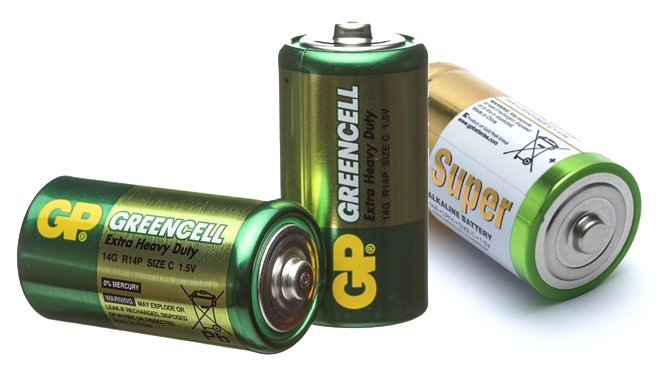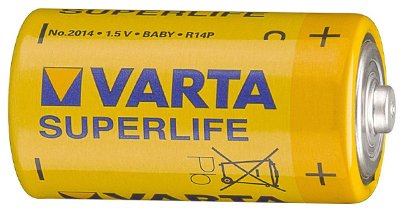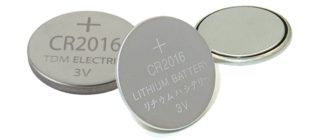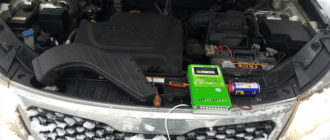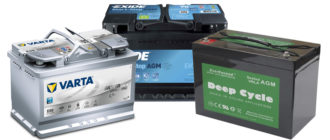Size C cylindrical batteries have been widely used to power flashlights and other portable electronic devices since the 1950s.
They are produced to date by most manufacturers of miniature power supplies. Due to their good aspect ratio and electrical capacitance, they are well-suited for medium-power devices.
Content
Specifications
Galvanic dry current sources of frame size C (size C according to US standards) according to IEC classification are designated R14, where the letter R denotes a circular shape, and 14 - its radius in millimeters. By the additional letter at the beginning of the international marking, you can determine the electrochemical composition of the battery (for salt elements it is not available).
International Class C Alkaline Batteries are labeled Lr14. In the former USSR, they were designated by digital code 343, where they were produced under the brand name Jupiter M.
These batteries are sometimes referred to as medium, inches, or esques (from the English C size designation). They have the following parameters:
- Battery Type Cf;
- cylindrical body;
- diameter 26.2 mm;
- 50 mm high;
- voltage - 1.5 volts;
- Capacity in saline from 3400 mAh;
- Alkaline capacity from 8000 mAh;
- working temperature: -18 to 55 degrees for alkaline;
- working temperature: from +10 to +25 for salt;
- weight - 50-70 grams;
- shelf life - up to 10 years in alkaline, 2 years in salt.
High-quality alkaline C batteries with a discharge current of 250-500 mA can last up to 24 hours, and with a high load of 1-2 amperes, up to 2.7 hours.
The best salt batteries have a capacity and a maximum current that is several times lower than alkaline batteries. They can be operated at currents up to 80-100 mA no more than 45 hours, and at currents up to 400 mA - no more than 9-10 hours.
Varieties and their features
The most common are salt (R14), alkaline (LR14) and nickel metal hydride (HR14) cylindrical elements of frame size C.
C-R14. Disposable saline batteries are the cheapest primary type of current source. R14 at 1.5 volts. According to the ANSI standard, they are designated 14D. They are light in weight and low in performance. They can be used only in devices with a small current consumption (up to 200-400 mA) at temperatures close to room temperature. At temperatures below zero, they lose their performance.
C-LR14. Alkaline (alkaline) sources current LR14 for one and a half volts are 2-3 times more expensive than salt, but they have 7-10 times more capacity and 5 times longer life. According to the ANSI standard, they are designated 14A. They weigh a little more than salt elements and can supply devices with a consumption current of up to 400-500 mA for a long time (several days) or devices with currents of up to 1-2 amperes for several hours, and also maintain their operability at a wider temperature range.
C-HR14. These are rechargeable nickel metal hydride batteries, which are more expensive than alkaline batteries and have the following characteristics:
- electrochemical formula of NiMH;
- rated voltage - 1.2 volts;
- capacity - 4000-6000 mA;
- the number of charge-discharge cycles - more than 500;
- weight - about 75 grams.
They have improved characteristics compared to nickel-cadmium models (the memory effect is significantly reduced, their environmental friendliness is improved) and, if used correctly, they can serve for many years.
Where type C batteries are used
Power supplies of size C are widely used in small-sized electrical appliances, electronic devices that consume small and medium currents.
- Kids toys;
- flashlights;
- musical instruments;
- radios.
Popular manufacturers, analogues and their features
Various manufacturers sometimes designate primary power supplies R (LR) 14 with their own designations, for example:
- 1235, 14A - Ever Ready;
- 4C, 814 - Rayovac;
- 3014, 4014 - Varta;
- E93 - Energizer
- AM2 - Panasonic;
- KC, K4A - Kodak;
- 14A, 14AC - Neda;
- 14G - GP.
- M14SHD, MN1400 - Procell, Duracell;
Almost all manufacturers duplicate their own marking generally accepted, so you can easily distinguish salt and alkaline by the presence of the letters R or LR, respectively.
It is better to purchase products from well-known manufacturers, which will last several times longer and will not present troubles in the form of a leaked electrolyte or a quick failure. Quality assurance can be obtained from brands such as Duracell, Rayovac, Varta, Energizer, Panasonic, Kodak, GP and others.
Cheaper, as a rule, salt batteries of comparatively low quality, are produced by Raymax, Videx, Mustang, Energycell, Cosmos and others.
Some manufacturers (for example, Eneloop) do not produce batteries of this size, but they produce special adapters (spacers) of sizes C and D, into which they are inserted AA batteries.
What to look for when choosing
When choosing size C batteries, pay attention to signs of damage and build quality. In addition, a number of manufacturers have different series of their products in terms of energy intensity, for example, a company Duracell produces two types of C batteries: Basic and Turbo Max (advanced version), which differ in price and performance.
There are commercially available SAFT lithium batteries with the same size marked LSH14 at 3.6 volts, as well as similar batteries from other manufacturers of size 26500 with the letters ER. When using such batteries in electrical appliances and devices instead of ordinary R / LR14 batteries (voltage 1.5 v) or HR / KR / ZR14 batteries (1.2 v), there is a risk of disabling them due to excess voltage more than 2 times.



